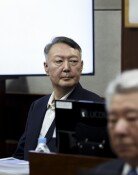700 MHz frequency band for right purpose
700 MHz frequency band for right purpose
Posted July. 21, 2015 07:14,
Criticism are raised over distribution of the 700MHz frequency band, which is to be determined by the Korean government on July 27. Concerns are growing that the governments distribution policy may give special privilege for terrestrial broadcast service providers and go against the national interest. The 700 MHz frequency band is likely to be divided into terrestrial Ultra High Definition (UHD) broadcasting, mobile tele-communication and national disaster communication as the ruling and the opposition lawmakers have agreed. This frequency band was returned to the government when TV broadcasting was converted from analogue to digital. Nations around the world have designated the frequency band to telecommunication. Korea is the only nation that decided to give the frequency band to terrestrial broadcasting.
Global practice is that the government assigns frequency bands. In Korea, however, politicians created a sub-committee in the National Assembly and agreed to assign the frequency band for UHD broadcasting. Terrestrial broadcast service providers have put pressures to politicians citing, Korean culture wave contents needs to be developed through UHD broadcasting. With General Election scheduled next year, lawmakers who are conscious of the power of terrestrial television channels accepted demands from the terrestrial broadcasters. Lawmakers are sensitive to how they are seen on terrestrial TV programs. If the terrestrial broadcasting companies intentionally air unpleasant images of a lawmaker, it will work against the lawmaker in elections. Terrestrial broadcasting companies aimed at such weakness to persuade lawmakers.
Kim Sung-woo, the senior presidential secretary for public relations, is the person who led efforts to secure the 700MHz frequency band at SBS, a local terrestrial TV channel, when he worked as the Planning Director of the broadcasting service provider. At public hearings or panel discussions on how to distribute the 700 MHz frequency band, Kim represented SBS and stressed that the frequency band must be assigned to the terrestrial TV channels. It remains questionable whether Kim, who is now working as a presidential secretary, may exercise influence over the related policies.
A research shows that mobile phone users may suffer from video lags during streaming on mobile phones in Seoul from the next year due to growing demand for mobile communication, unless the new frequency band is assigned to mobile communication service providers. If the government sells the frequency band to telecommunication service providers, it will generate 1.3 trillion won (approx. USD 1.124 billion) as the revenue of government. In addition, it is urgent to assign the 700 MHz frequency band to the telecommunication area in order to develop technologies for autonomous vehicles or Internet of Things (IoT) in the future. The worst choice would be giving away the frequency band, the nations scarce resource, to terrestrial TV channels without any cause or interest for the public.
Terrestrial broadcasting service providers argue that using the frequency band for UHD broadcasting serves the public interest. However, only 6.8 percent of households across the nation directly receives terrestrial broadcasting. It is possible to transmit the UHD broadcasting through satellite cable based internet TVs. It is expected to take 20 years until the UHD is commonly aired in Korea. Terrestrial broadcasting companies intends to secure the frequency band for free, which they do not use for a while. It is not desirable when the Assembly speaks for terrestrial broadcasting companies, said Choi Yang-hee, head of the Ministry of Science, ICT and Future Planning, at a discussion last Friday. The minister, who is in charge of the policies that has the nations future at stake, must not evade responsibility by blaming others. If a policy is wrong, the government must correct the policy now.




![‘딸’ 같아서…상가 담보로 내준 치매부부, 6억 털렸다[히어로콘텐츠/헌트①-下]](https://dimg.donga.com/c/138/175/90/1/wps/NEWS/IMAGE/2025/12/14/132963612.1.jpg)


